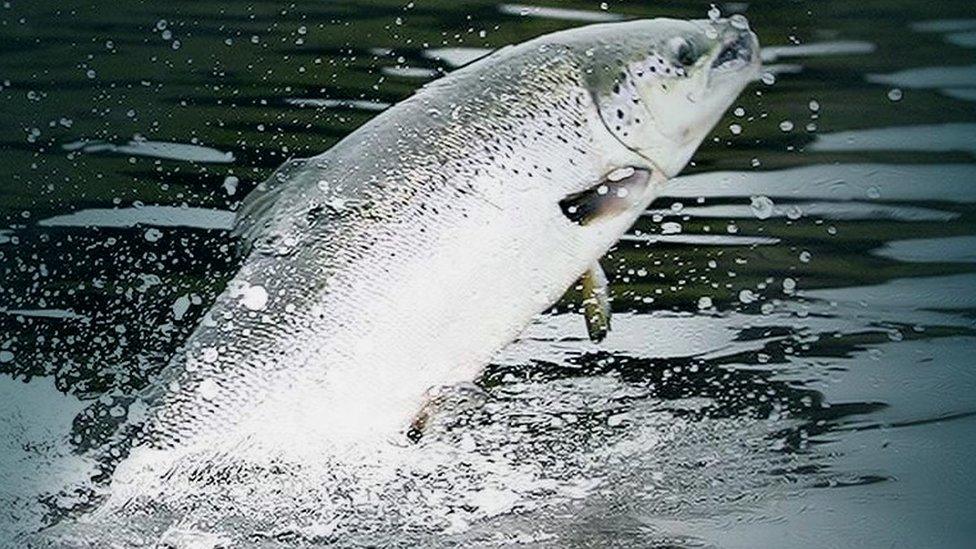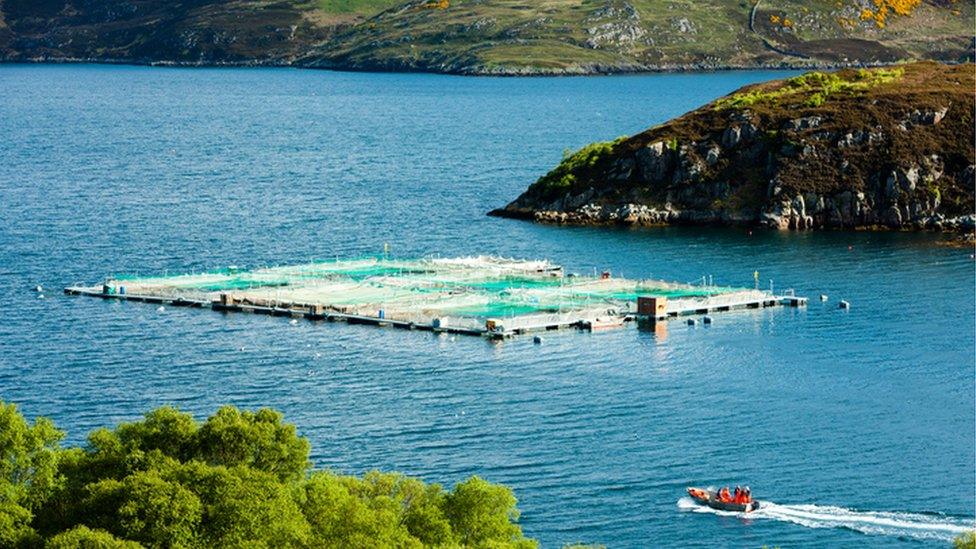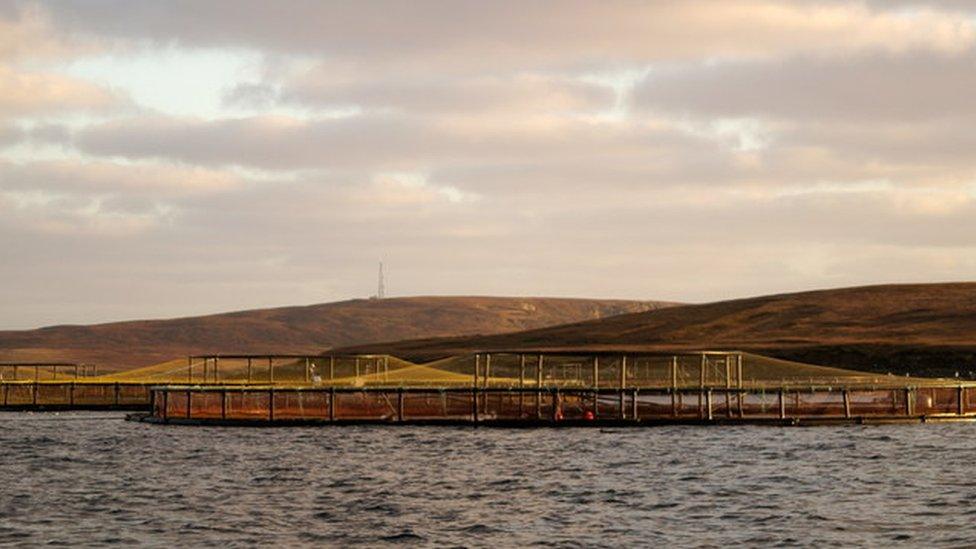Scottish salmon farming's sea lice 'crisis'
- Published

As the latest figures reveal a significant drop in the weight of Scottish salmon being farmed in the last three months of 2016, BBC Scotland's Business and Economy editor Douglas Fraser considers the impact of sea lice on the industry.
The Scottish salmon farming industry is facing major problems from sea lice, which have led to a cut in output, fast rising costs and a big rise in prices.
The problem is not new, but it has burgeoned during this decade. Chemicals have been extensively used, but lice are becoming increasingly resistant.
Bathing the salmon in warm water is an expensive treatment, but it led to the accidental slaughter of 95,000 fish in one incident last year.
The industry has admitted it has a serious problem, and is spending at least £30m a year on measures to respond to it.
That is in addition to reduced profits and lower production, down worldwide by an estimated 7% last year.
Ian Bricknell, an expert with experience of aquaculture research from Aberdeen and now at the University of Maine, says the cost to the whole Atlantic salmon farming industry is at least £400m.

Marine Harvest, the largest producer of Scottish salmon, says it is losing around 1,500 tonnes of fish per year, out of nearly 40,000 tonnes produced.
As consumer demand for fish increases, the price has soared to record levels in recent months. That is expected to feed through to shoppers this year, as new supply contracts are signed.
The Norwegian-based company published figures that show:
Scotland has by far the highest incidence of sea lice. In a survey published last year, the share of affected sites went from 28% in 2014 to 49% in 2015. That is while the Norwegian level remained at 5% and in Irish fish farms it went form 8% to 18%.
The amount of hydrogen peroxide, a chemical treatments to combat sea lice, rose by 15 times between 2011 and 2015, reaching 42 litres of bleach per tonne of fish produced. The industry emphasises that this is done with veterinary approval.


Sea lice can weaken the health of salmon and their growth
What are sea lice?
Small marine parasites that feed on the skin and blood of salmon. They can weaken the health of fish and its growth.
Can typically float on the tide for 30km, but they have been known to travel 100km.
Can be brought into sea lochs on wild salmon, though they are removed when the fish enter freshwater rivers.
Numbers have increased through the intensity of fish farms, and may also have been boosted by rising sea temperatures.
Treatments include dousing with fresh or warm water, which knocks lice off the salmon. Hydrogen peroxide bleach is another treatment.
Sea lice are not known to have any effect on people when salmon is eaten.

In its most recent report, Marine Harvest said the problem was affected by rising water temperatures, rough weather, too few fish available that eat sea lice, and limited access to warm or fresh water treatments.
"This was particularly evident in Scotland, where heavy lice burdens compromised results," the company report stated. "These developments consequently affected the group's overall results."
To combat other fish disease, Marine Harvest use of antibiotics rose in Scotland to 24 grammes per tonne of fish produced, before falling back in 2015 to one gramme.
Major problems with infection in Chile, another large salmon producer, saw antibiotics rise to 573 grammes per tonne.

The Scottish Salmon Company, based in Edinburgh, recently reported "exceptional mortality" of fish in the July to September quarter, with 1,300 tonnes destroyed. It said production costs per kilo of fish produced rose by nearly 30% in a year.
In an interview with BBC Scotland, Steve Bracken of Marine Harvest said there was a need to develop more effective ways to combat lice.
He said: "We've had a mortality problem here in 2016 which, for us, is not acceptable. We reckon lice and associated poor growth could be in the region of 1,500 tonnes of fish that we've lost because of sea lice". That is out of more than 40,000 tonnes of annual production.
Major accident
He spoke about the incident on Skye last summer when there was a major accident with new machinery for pumping salmon through warm water to dislodge lice. As a result, nearly 100,000 fish died, and 460 tonnes of waste fish had to be dumped.
"The welfare of the fish we have in our care is our top priority, so It was extremely regrettable," he said. "The fish had been previously compromised with amoebic gill disease, so they were already weak."
He disputed reports that the fish had been accidentally cooked, saying the water temperature was 34 degrees Celsius. Salmon usually swim in temperatures of between 4 and 15 degrees, and the Thermolicer device is designed to pump them through the warm water for only about 20 seconds.

Salmon farming industry facts:
Unilever began Scottish salmon farming in 1965 and produced its first fish from Lochailort in 1971.
The industry grew rapidly in the 1980s and 1990s, with production rising to more than 170,000 tonnes during 2014.
Most of the production is by six companies, mostly controlled from headquarters in Norway or listed on the Oslo stock market.
About 60% of Scottish farmed salmon is sold to British consumers. Export markets are led by the USA, which bought 30,000 tonnes of the fish in 2015, worth £160m.
There are about 250 salmon farming sites off the coast of Scotland and its islands, none of them allowed off the east coast of the mainland.
Direct employment in Scottish fish farming is estimated at more than 2,200.
Scott Landsburgh, chief executive of the Scottish Salmon Producers Association, said sea lice are the subject of scare stories from campaigners against fish farming.
"Sea lice is a natural phenomenon, albeit that it's made more odd because it's in a farming environment," he said. "All livestock on farms, terrestrial or marine, are encountering some kind of parasite or a tick, and they're dealt with. And that's part of livestock farming.
"If you go to any of our fish farms or processing units in Scotland, you'll see fantastic fish - really high-quality shiny, fantastically healthy-looking fish. We make fantastic quality, the best farmed salmon in the world, and we should be proud of it."
Prof Frank Asche, a marine scientist with the University of Florida, who previously researched the industry at Stavanger in Norway, said sea lice represent an economic challenge, although the high price is helping cover the additional costs of treatment.
He said: "It's a bigger challenge now that they have a parasite that they cannot handle well".
He argued the industry is still young, and it will be like land-based farming, in that it will find solutions to problems of disease and parasites.
- Published14 February 2017